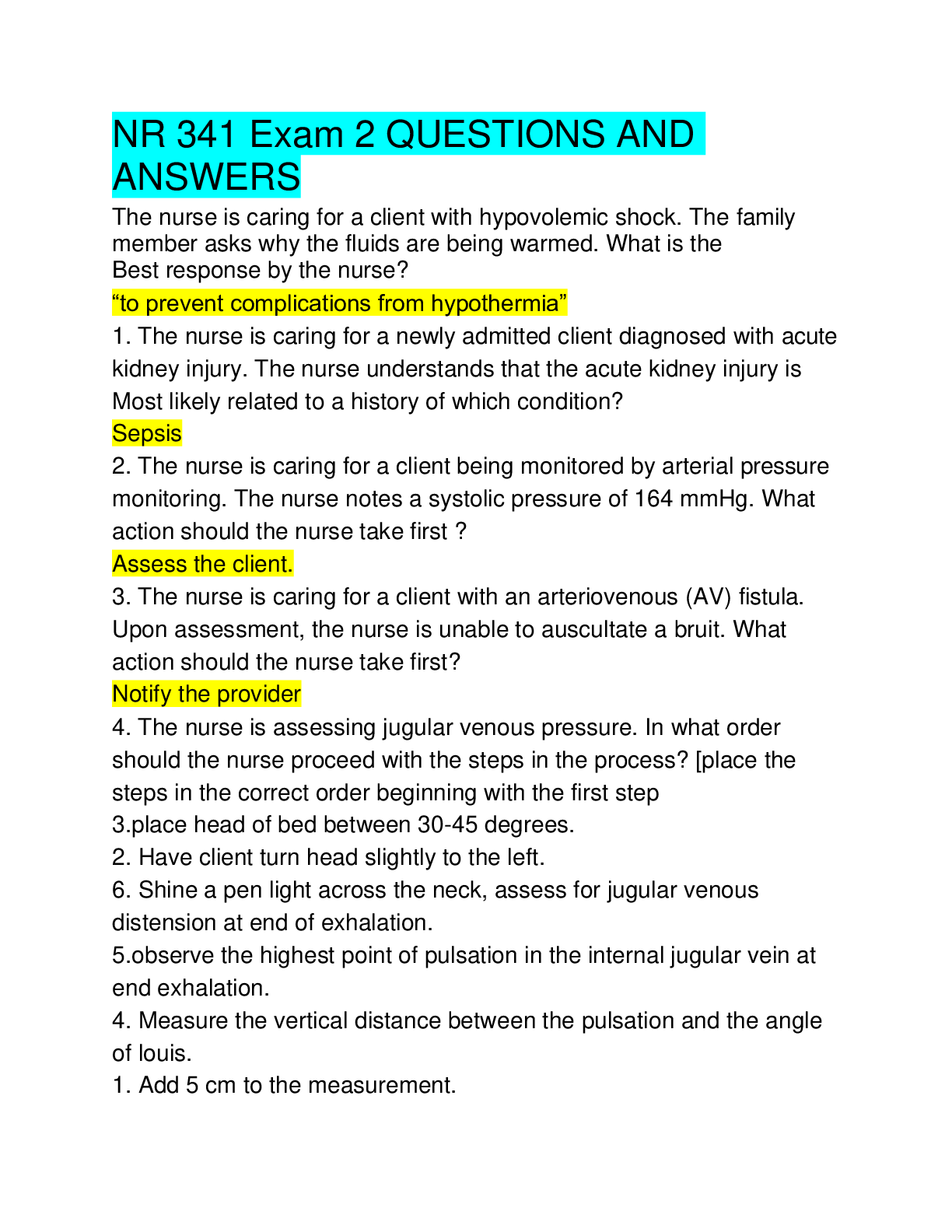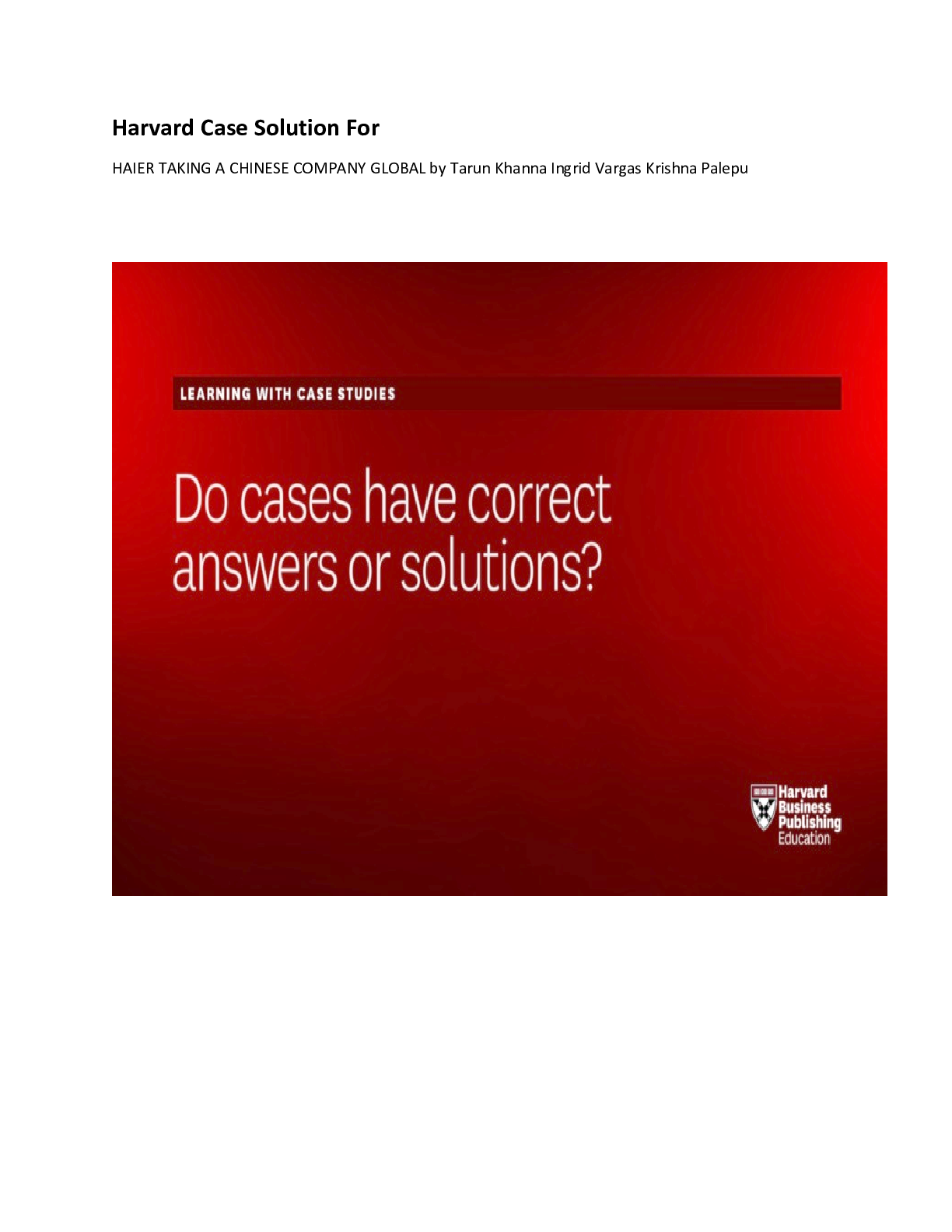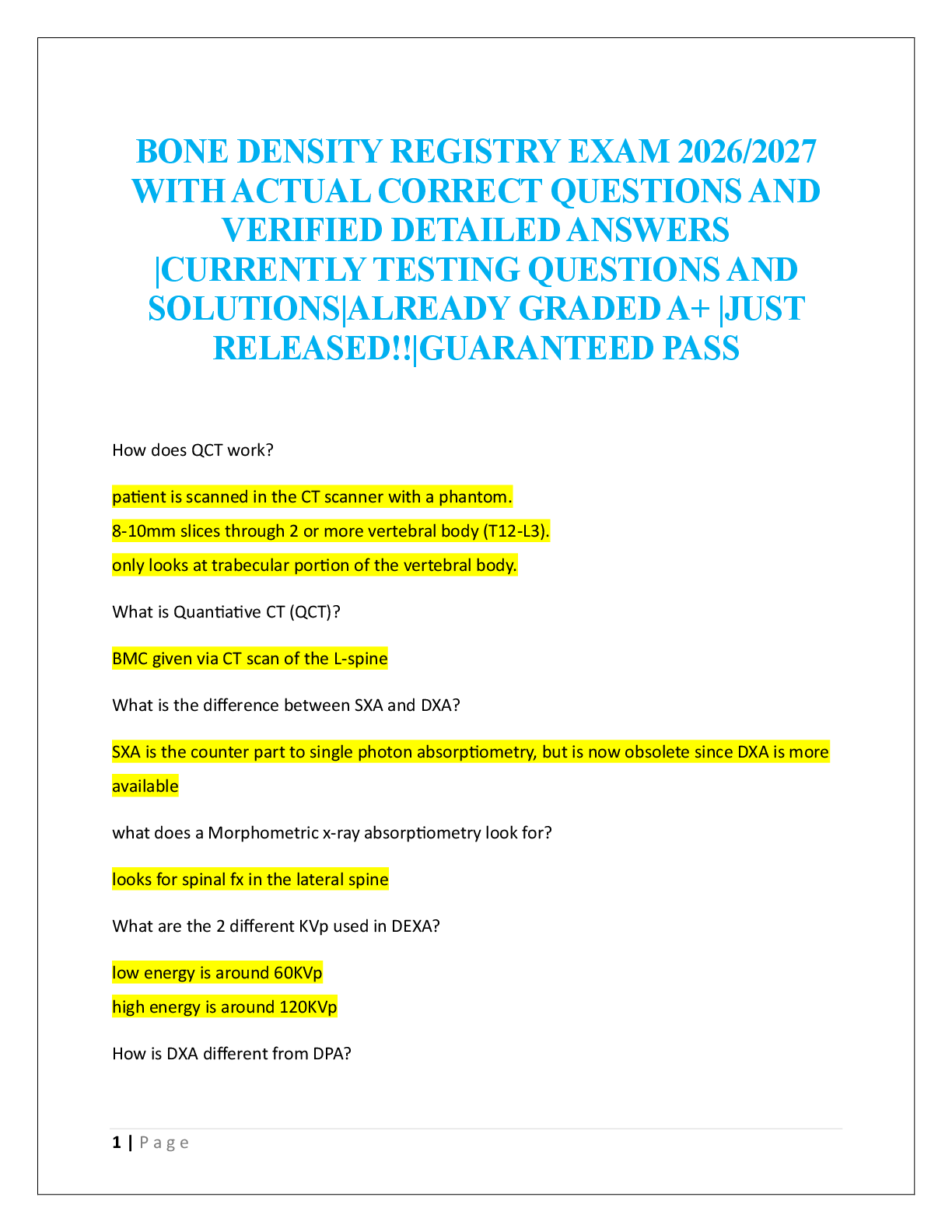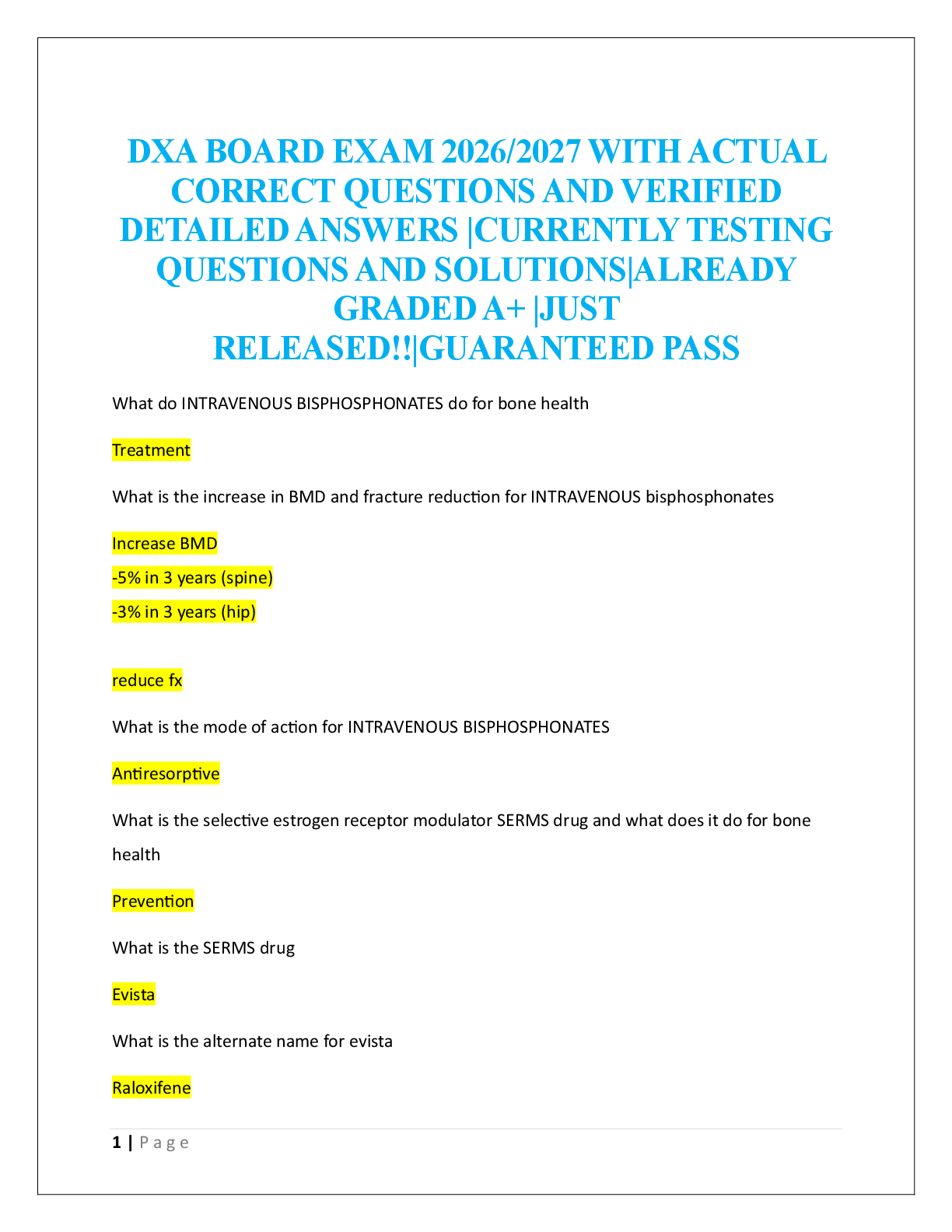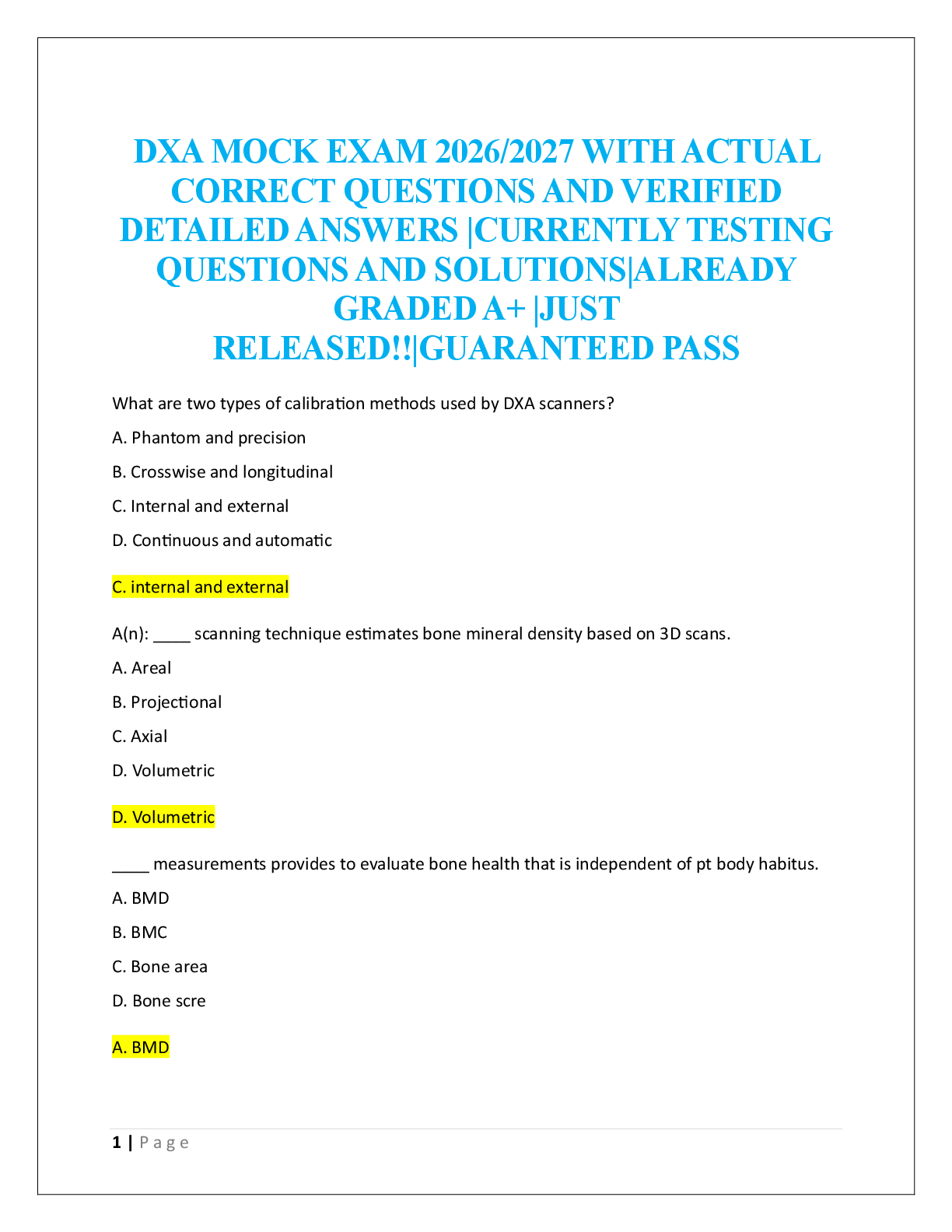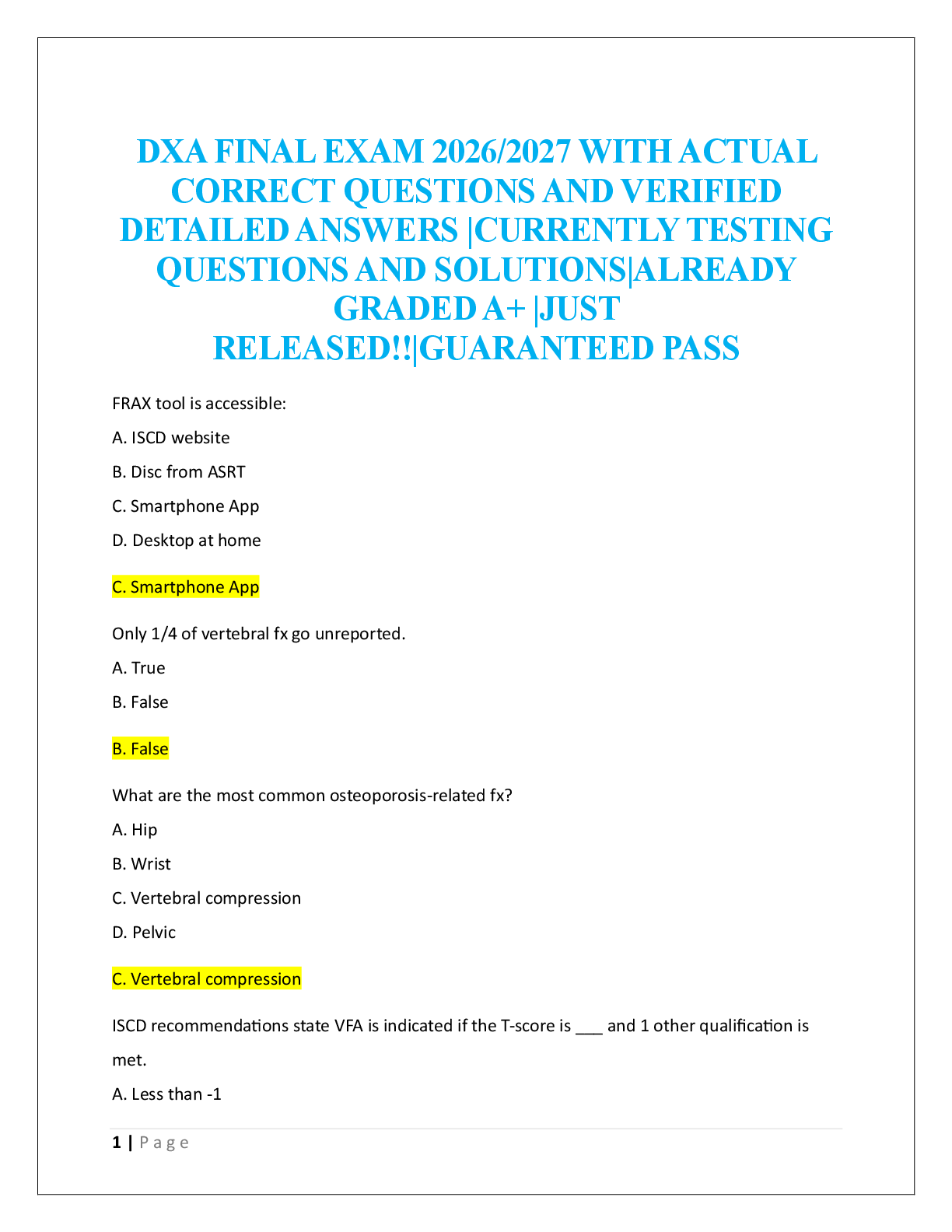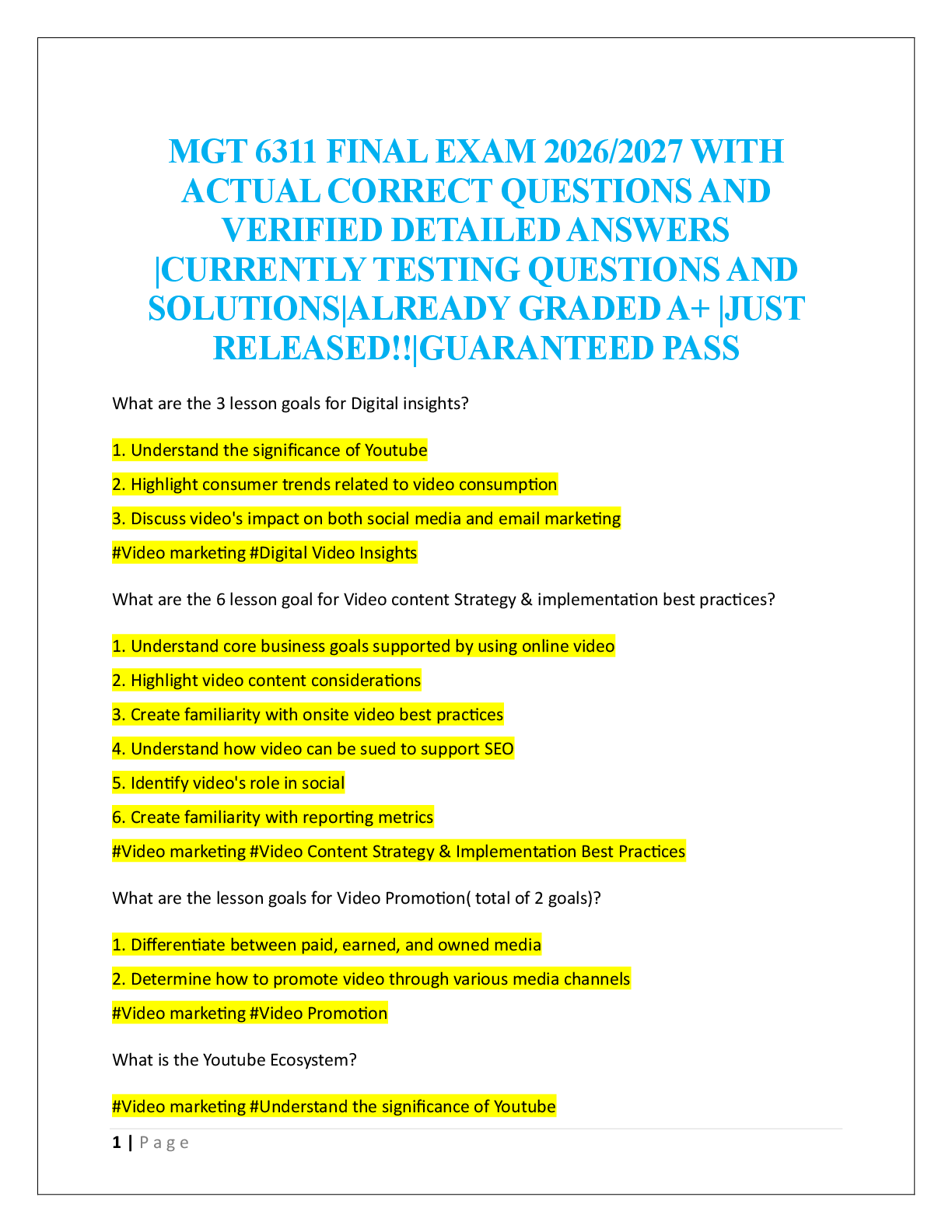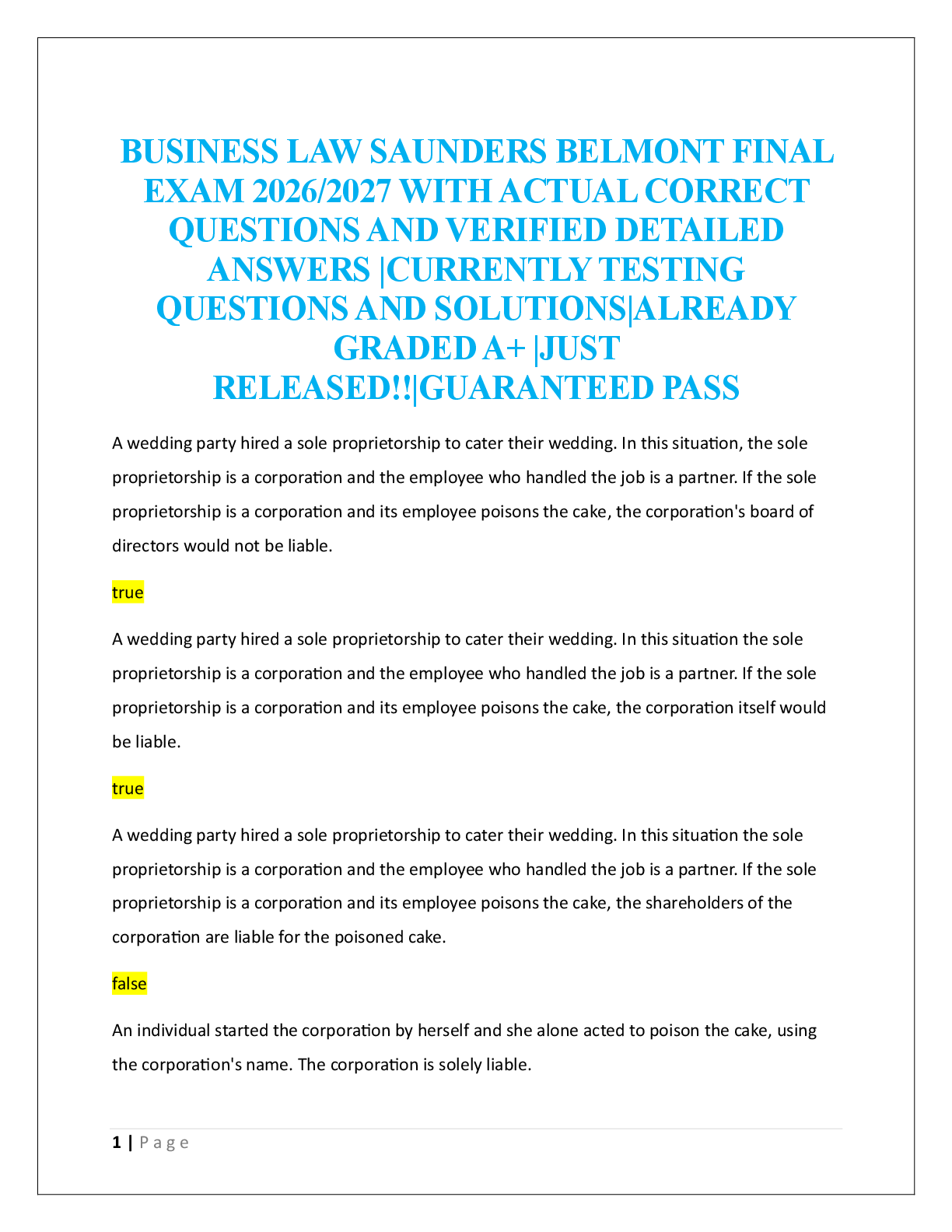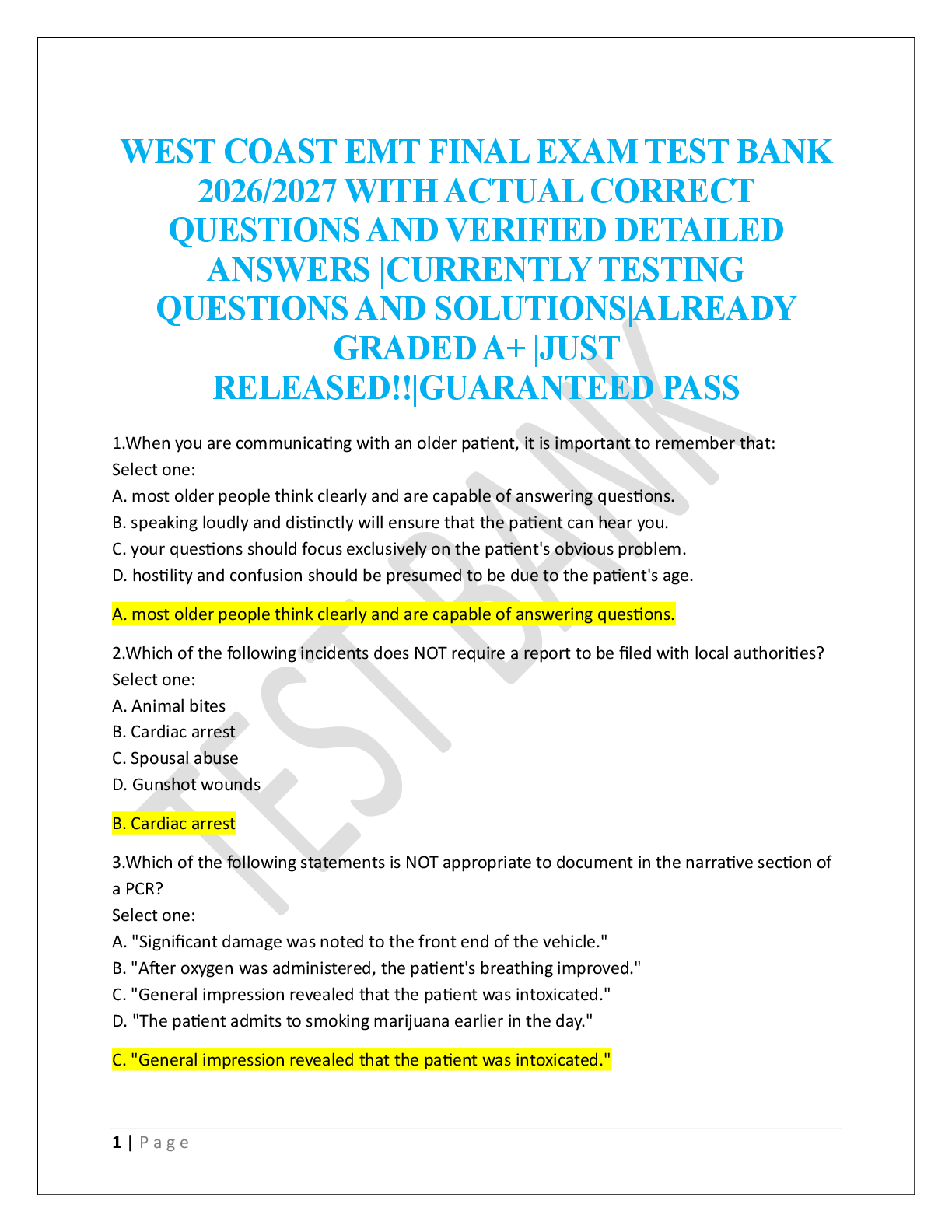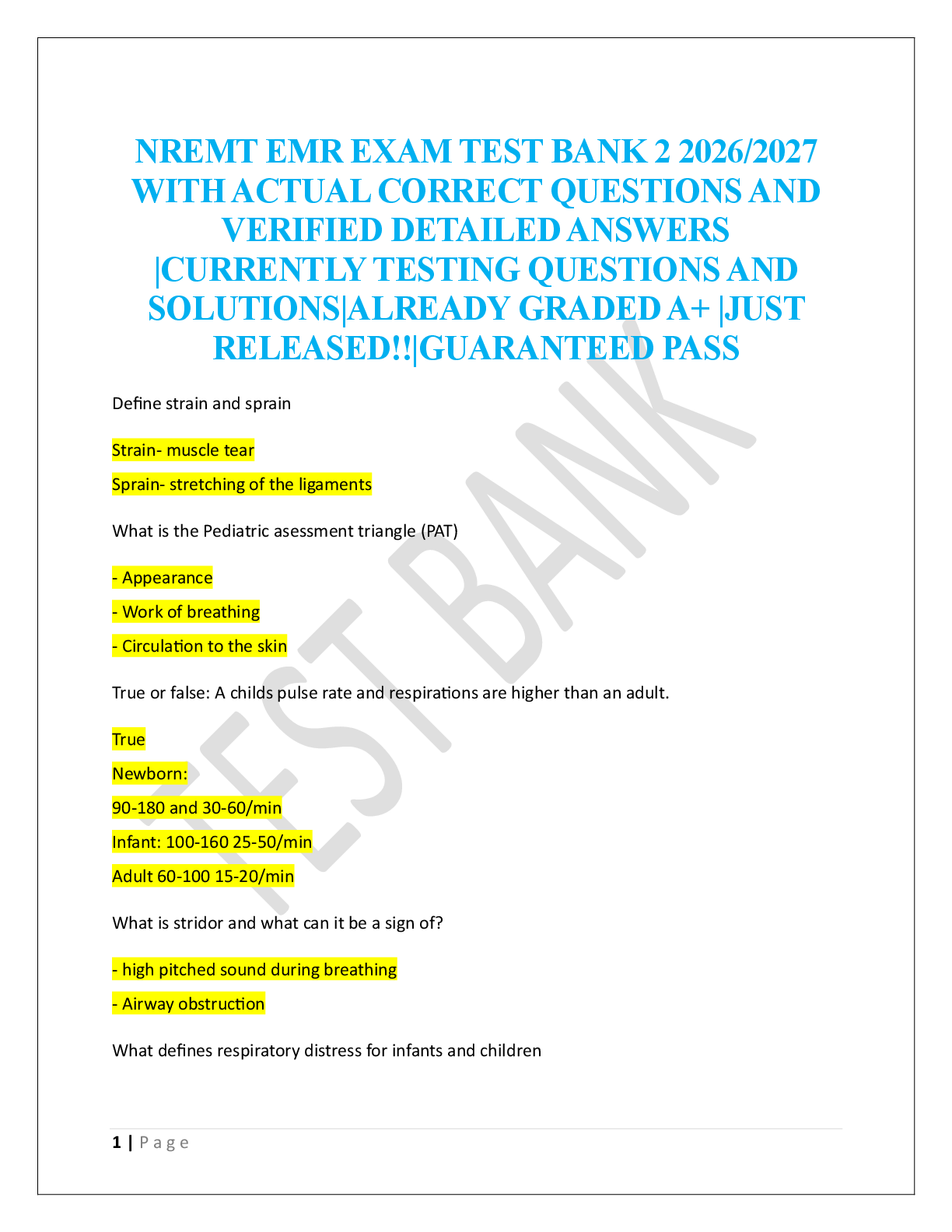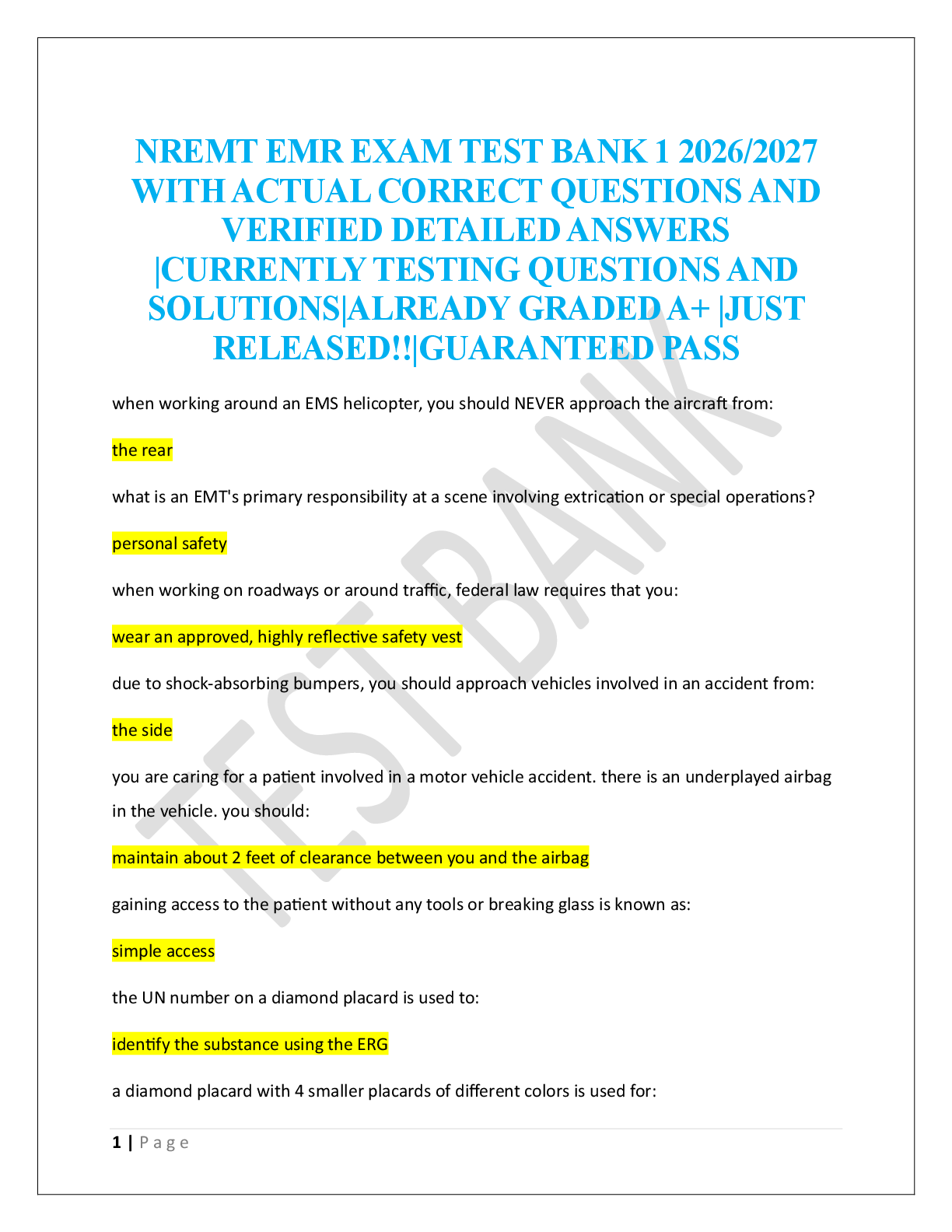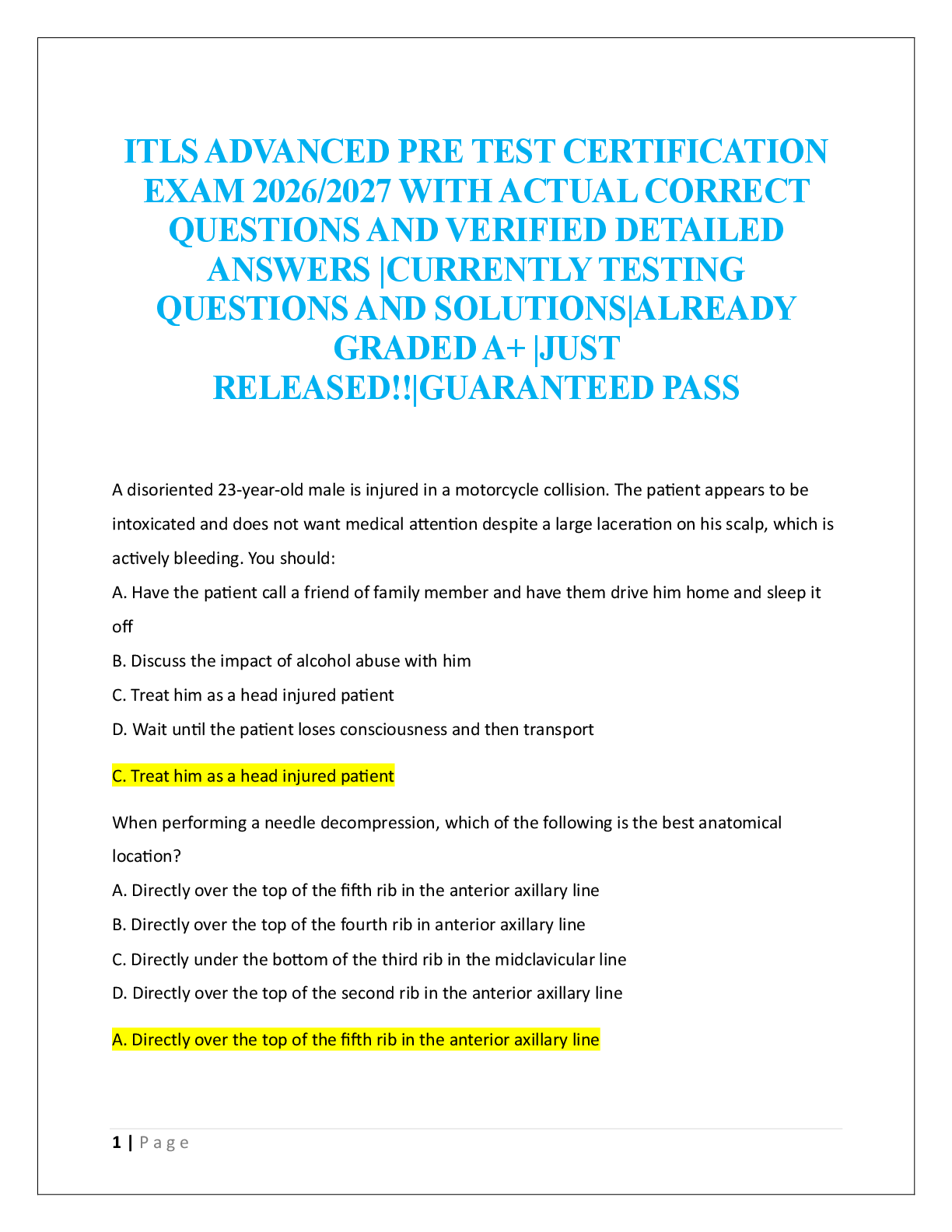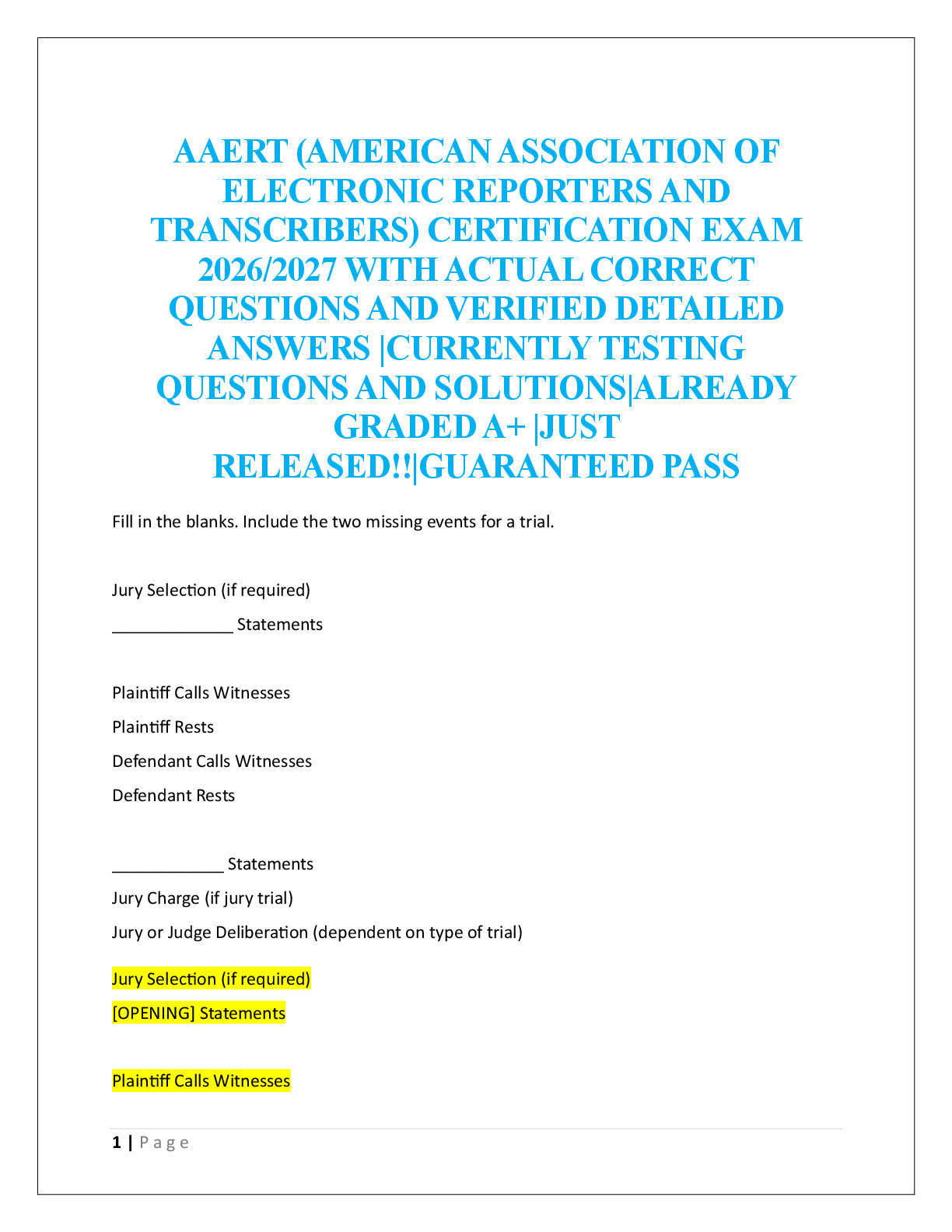BIOL 121 Chapter 10 and 11 questions | 2020/2021
Document Content and Description Below
Chapter 10 questions 1. Which muscle draws the corner of the mouth laterally, and is innervated by the facial nerve (N VII)? a. depressor anguli oris b. risorius c. levator anguli oris d. zyg ... omaticus major 2. Which muscle of facial expression originates on the maxilla and zygomatic bone, superior to the infra-orbital foramen, and is innervated by CN VII? a. orbicularis oculi b. levator anguli oris c. levator labii superioris d. zygomaticus minor 3. Which of the following muscles of mastication is innervated by the trigeminal nerve (N V), and acts to elevate the mandible and close the jaw, or to move the mandible side to side? a. medial pterygoid b. masseter c. temporalis d. lateral pterygoid 4. Which of the following most accurately describes the inferior oblique muscle? a. It is innervated by the trochlear nerve (N IV). b. It facilitates the action in which the eye looks down and laterally. c. It is innervated by the abducens nerve (N VI). d. It inserts into the inferior and lateral surfaces of the eyeball. 5. Which of the following statements regarding the depressor labii inferioris muscle is true? a. It originates on the mandible between the anterior midline and the mental foramen. b. It inserts into the skin at the angle of the mouth. c. It depresses the lower lip and is innervated by the trigeminal nerve (N V). d. It compresses and purses the lips. 6. Laryngeal elevator muscles (palatopharyngeus, salpingopharyngeus, and stylopharyngeus) are innervated by which of the following cranial nerves (CN)? a. CN V and CN VII b. CN VII and CN X c. CN X and CN IX d. CN X and CN XI 7. Which muscle originates on the mandible’s medial surface around the chin, inserts into the body of the tongue and the hyoid bone, and is innervated by the hypoglossal nerve (N XI)? a. genioglossus b. hyoglossus c. geniohyoid d. mylohyoid 8. Which of the following is true regarding the anterior muscles of the neck? a. They control the position of the pharynx. b. They elevate the mandible. c. They are all innervated by the facial nerve (N VII). d. They provide a stable foundation for muscles of the tongue. 9. Which of the following statements regarding the tensor veli palatini muscle is correct? a. It partially originates on the pterygoid process of the sphenoid, inserts into the median raphe, and is innervated by CN IX. b. It partially originates on the sphenoidal spine, inserts into the soft palate, and is innervated by CN X. c. It partially originates on the petrous portion of the temporal bone, inserts into the soft palate, and is innervated by CN V. d. It partially originates in the tissues around the auditory tube, inserts into the soft palate, and is innervated by CN V. 10. Which of the following accurately describes the mylohyoid? a. It originates from the inferior surface of the mandible at the chin, inserts into the median raphe attached to the hyoid bone, and is innervated by the facial nerve (N VII). b. It inserts into the median connective tissue band that runs to the hyoid bone, and it elevates the floor of the mouth. c. It originates on the mylohoid line of the maxilla, inserts into the median raphe attached to the hyoid bone, and is innervated by the maxillary branch of CN V. d. It acts to depress the mandible, open the mouth, and/or elevate the larynx. 11. Which of the following muscles is (are) located in the superficial layer of vertebral column muscles? a. erector spinae muscles b. multifidus muscles c. splenius muscles (splenius capitis, splenius cervicis) d. intertransversarii muscles 12. Which of the following muscles of the vertebral column is a spinal flexor muscle that also limits hyperextension? a. semispinalis cervicis b. longus colli c. spinalis thoracis d. interspinalis 13. Which muscle of the vertebral column inserts into the spinous processes of C5–T4, extends the vertebral column, and is innervated by the thoracic spinal nerves? a. semispinalis thoracis b. longissimus thoracis c. spinalis thoracis d. rotatores thoracis 14. Which of the following statements regarding muscles of the vertebral column is true? a. The intrinsic back muscles, which are innervated by the ventral rami of associated spinal nerves, interconnect and stabilize the vertebrae. b. The splenius muscles of the intermediate layer of intrinsic back muscles perform flexion or lateral extension of the neck. c. The transversospinalis muscles are all relatively short muscles that work in various combinations to produce slight extension or rotation of the vertebral column. d. The erector spinae muscles of the intermediate layer of the intrinsic back muscles flex the vertebral column when contracting together. 15. Which of the following statements accurately describes the rotatores lumborum muscle? a. It originates on the transverse processes of the vertebrae in the lumbar region and rotates the vertebral column toward the opposite side. b. It originates on the spinous processes of the vertebrae in the lumbar region and flexes the vertebral column. c. It inserts into the transverse processes of adjacent, more inferior vertebrae and is innervated by lumbar spinal nerves. d. It inserts into the transverse processes of adjacent, more superior vertebrae and is innervated by CN XI. 16. Of the oblique and rectus muscles, which of the following elevates the ribs and enlarges the thoracic cavity? a. internal intercostals b. superior serratus posterior c. transversus abdominis d. rectus abdominis 17. Which of the following muscles is innervated by phrenic nerves (C3–C5) and compresses the abdominopelvic cavity upon contraction? a. diaphragm b. rectus abdominis c. external oblique d. internal oblique 18. Which muscle originates on the external and inferior borders of ribs 5–12 and acts to depress the ribs, compress the abdomen, and to flex, laterally flex, or rotate the vertebral column to the opposite side? a. inferior serratus posterior b. internal oblique c. external oblique d. external intercostals 19. Which of the following statements regarding the transversus abdominis muscle is correct? a. It originates on the inguinal ligament and thoracolumbar fascia, compresses the abdomen, and is partially innervated by intercostal nerves (T7–T12). b. It originates on the iliac crest and thoracolumbar fascia, compresses the abdomen, and is partially innervated by intercostal nerves (T5–T12). c. It inserts into the linea alba and pubis, extends the vertebral column, and is partially innervated by the iliohypogastric nerve. d. It inserts into the central tendinous sheet of the diaphragm, compresses the abdomen, and is partially innervated by the thoracic nerves (T9–T12). 20. Which of the following most accurately describes the inferior serratus posterior muscle? a. It originates from the thoracolumbar fascia and inserts into the inferior borders of ribs 2–5. b. It originates on the aponeurosis from the spinous processes of C7–T3 and ligamentum nuchae, inserts into the inferior borders of ribs 8–12, and is innervated by phrenic nerves (C3–C5). c. It inserts on the inferior borders of ribs 9–12, and is innervated by the intercostal, iliohypogastric, and ilioinguinal nerves. d. It inserts on the inferior borders of ribs 9–12 and acts to pull ribs inferiorly and also outward, opposing the action of the diaphragm. 21. The ischial and pubic rami are sites of origin for which of the following perineal muscles? a. male bulbospongiosus muscle b. deep transverse perineal muscle c. female external urethral sphincter d. ischiocavernosus muscle 22. Which of the following is classified as a muscle in the anal triangle? a. pubococcygeus muscle b. deep transverse perineal muscles c. external urethral sphincter d. ischiocavernosus muscle 23. Which of the following statements regarding the pelvic diaphragm is true? a. It is a muscular layer that overlies deeper muscles that strengthen the pelvic floor and encircle the urethra. b. It is a deep muscle layer that extends between the pubic bones. c. It forms the muscular foundation of the anal triangle. d. It completely closes the pelvic outlet. 24. Which of the following statements most accurately describes the bulbospongiosus muscle in females? a. It originates on the perineal body; partially inserts into the perineal membrane, body of clitoris, and corpus spongiosum; and compresses the bulbo-urethral glands. b. It originates on the central tendon of the perineum and partially inserts into the perineal membrane and corpus cavernosum. c. It partially inserts into the bulb of vestibule, perineal membrane, and corpus spongiosum, and is innervated by the inferior sacral nerves (S4–S5). d. It originates on the ischial and pubic rami, acts to close the urethra, and is innervated by the hemorrhoidal branch of the pudendal nerve (S2–S4). 25. Which of the following statements regarding the male external urethral sphincter is correct? a. It partially originates on the ischial ramus, inserts into the median raphe at the base of the penis, and compresses the bulbo-urethral glands. b. It partially originates on the ischial spine, inserts into the median raphe at the base of the penis, and compresses the greater vestibular glands. c. It inserts into the median raphe at the base of the penis and inner fibers encircling the urethra, opens the urethra, and is innervated by the inferior sacral nerves (S4–S5). d. It inserts into the median raphe at the base of the penis, compresses the greater vestibular glands, and is innervated by the inferior sacral nerves (S4–S5). 26. Which of the following statements regarding the muscles of the vertebral column is true? a. The muscles of the iliocostalis group of erector spinae muscles are innervated by cervical, thoracic, or lumbar spinal nerves. b. The splenius muscles of the superficial layer have their insertion on the transverse processes of middle and superior cervical vertebrae. c. The action of the longissimus group includes stabilization of lumbar vertebrae in flexion. d. The quadratus lumborum muscle of the spinal flexors acts to extend the vertebral column and to stabilize the diaphragm during exhalation. Chapter 11 1. Which of the following muscles inserts at the greater tubercle of the humerus? a. teres minor b. subscapularis c. deltoid d. coracobrachialis 2. Which of the following muscles rotates the scapula so that the glenoid cavity moves inferiorly (downward rotation) and elevates the ribs if the scapula is stationary? a. serratus anterior b. rhomboid major c. rhomboid minor d. pectoralis minor 3. Which of the following is/(are) an action(s) of the teres minor muscle? a. lateral rotation and adduction at the shoulder b. medial rotation at the shoulder c. abduction at the shoulder d. flexion at the elbow 4. The axillary nerve innervates which of the following muscles? a. supraspinatus b. teres major c. deltoid d. infraspinatus 5. The dorsal scapular nerve (C5) innervates which of the following muscles? a. trapezius b. rhomboid minor c. serratus anterior d. pectoralis minor 6. The infraglenoid tubercle of the scapula is the site of origin for which of the following muscles? a. long head of triceps brachii b. lateral head of triceps brachii c. biceps brachii d. brachioradialis 7. With the forearm pronated, which muscle CANNOT function effectively due to the position of its muscular insertion? a. anconeus b. triceps brachii c. biceps brachii d. supinator 8. The extensor carpi radialis longus is innervated by which nerve? a. median nerve b. ulnar nerve c. musculocutaneous nerve d. radial nerve 9. The deep branch of the ulnar nerve (C8–T1) innervates which of the following muscles? a. abductor pollicis brevis b. dorsal interosseous muscles c. opponens pollicis d. extensor digitorum 10. Which of the following is an action of the palmar interosseous hand muscles? a. adduction at metacarpophalangeal joints of digits 2, 4, and 5 b. abduction of thumb c. extension at interphalangeal joints d. abduction at metacarpophalangeal joints of digits 2–4 11. Which muscle inserts into the greater trochanter of the femur? a. tensor fascia latae b. adductor brevis c. pectineus d. piriformis 12. Which muscle facilitates extension and lateral rotation at the hip? a. gluteus minimus b. adductor brevis c. gluteus medius d. gluteus maximus 13. The gemelli are members of which of the following muscle groups? a. gluteal group b. lateral rotator group c. adductor group d. iliopsoas group 14. The inferior ramus is the site of origin for which muscle? a. pectineus b. adductor magnus c. iliacus d. piriformis 15. The iliacus muscle is innervated by which nerve? a. femoral nerve b. obturator nerve c. inferior gluteal nerve d. superior gluteal nerve 16. Which of the following muscles originates on the anterior surface of the fibula? a. flexor digitorum longus b. flexor hallucis longus c. extensor digitorum longus d. plantaris 17. The posterior surface of the medial condyle of the tibia is the site of insertion for which of the following muscles? a. biceps femoris b. popliteus c. semimembranosus d. rectus femoris 18. Which of the following muscles inserts at the base of the first metatarsal bone and medial cuneiform? a. fibularis longus b. fibularis brevis c. gastrocnemius d. a and b 19. Which nerve innervates the biceps femoris muscle? a. tibial nerve b. sciatic nerve c. femoral nerve d. deep fibular nerve 20. The tibial nerve innervates which of the following muscles? a. tibialis anterior b. soleus c. fibularis brevis d. gastrocnemius 21. Which muscle(s) abducts the metatarsophalangeal joints of digits 3-4 of the foot? a. flexor hallucis brevis b. dorsal interossei muscles c. abductor hallucis d. plantar interossei muscles 22. The extensor carpi ulnaris muscle is in which forearm compartment of the upper limb? a. superficial anterior compartment b. deep anterior compartment c. lateral compartment d. posterior compartment 23. The extensor carpi ulnaris muscle is in which forearm compartment of the upper limb? a. superficial anterior compartment b. deep anterior compartment c. lateral compartment d. posterior compartment 24. Which of the following is/are a function(s) of the adductor hallucis muscle? a. abduction at metatarsophalangeal joint of hallux b. extension at metatarsophalangeal joint of hallux c. flexion at metatarsophalangeal joint of hallux d. a and b 25. Flexion at joints of digits 2-5 of the foot is an action of which of the following muscles? a. abductor digiti minimi b. quadratus plantae c. abductor hallucis d. flexor hallucis brevis 26. Which of the following muscles is/are innervated by the lateral plantar nerve? a. flexor hallucis brevis b. flexor digitorum brevis c. adductor hallucis d. abductor hallucis 27. The anterior interosseous artery supplies which of the following upper limb compartments? a. anterior compartment of the arm b. superficial anterior compartment of the forearm c. deep anterior compartment of the forearm d. lateral compartment of the forearm [Show More]
Last updated: 3 years ago
Preview 1 out of 8 pages

Buy this document to get the full access instantly
Instant Download Access after purchase
Buy NowInstant download
We Accept:

Reviews( 0 )
$13.00
Can't find what you want? Try our AI powered Search
Document information
Connected school, study & course
About the document
Uploaded On
Feb 12, 2021
Number of pages
8
Written in
All
Additional information
This document has been written for:
Uploaded
Feb 12, 2021
Downloads
0
Views
52


